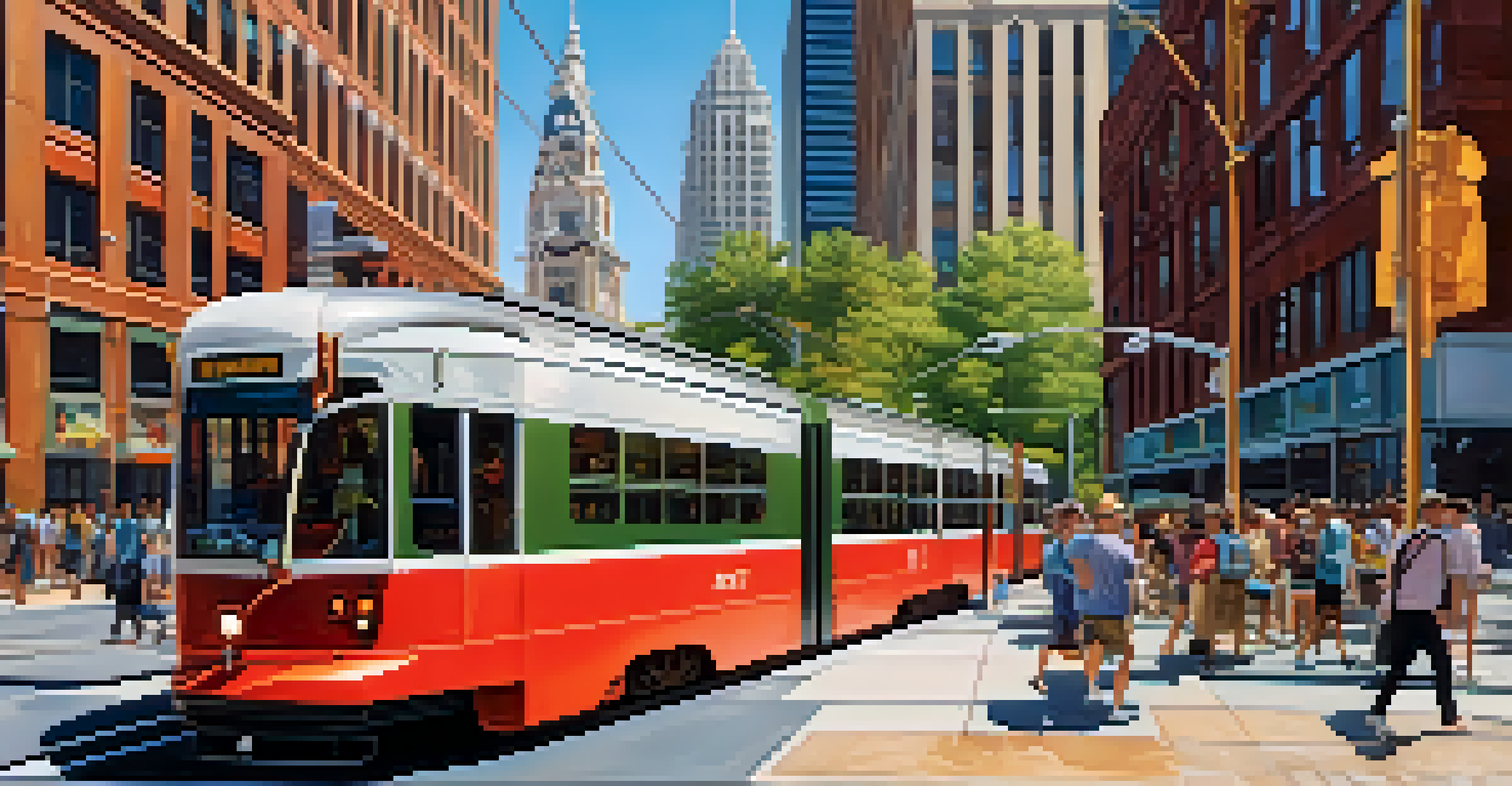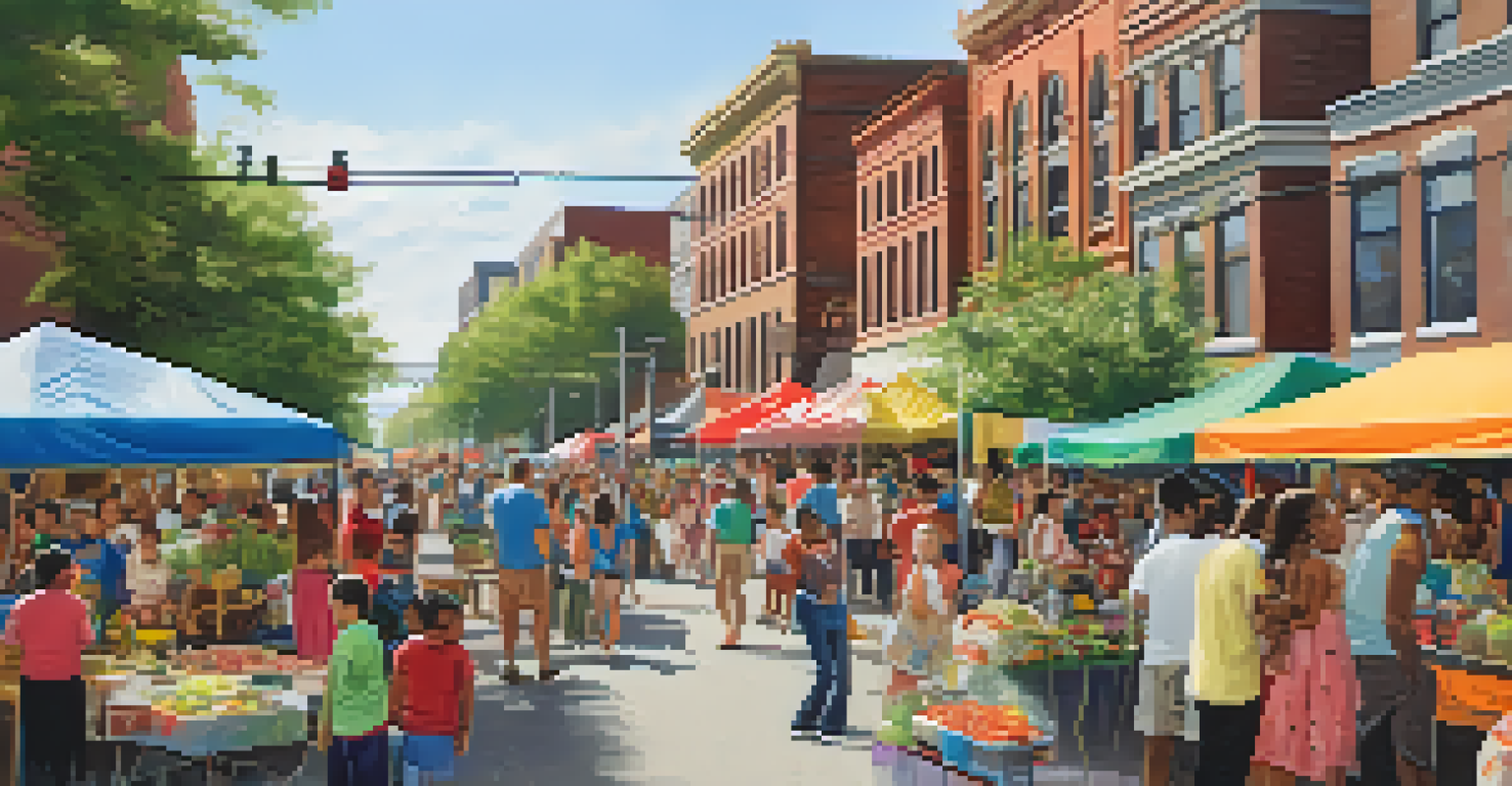Streetcars in Atlanta: A Ride Through the Early 20th Century

The Birth of Streetcars in Atlanta: A New Era Begins
In the late 19th century, Atlanta was on the brink of transformation. The introduction of streetcars in the early 1900s marked a pivotal moment, allowing residents to travel more freely across the city. This new mode of transportation not only connected neighborhoods but also fueled the growth of businesses and communities.
Public transportation is the backbone of a city’s economy and a lifeline for its residents.
The first streetcar lines were horse-drawn, but advancements soon led to electric streetcars, making travel faster and more efficient. Imagine the excitement of thousands of Atlantans hopping aboard these shiny new vehicles, eager to explore their city. With each stop, the streetcars not only transported people but also shaped the urban landscape, paving the way for modern Atlanta.
As streetcar lines expanded, they played a significant role in the city’s development. Areas that were once isolated became bustling hubs of activity, and soon, new homes, shops, and schools sprang up along these routes. This transportation revolution was more than just about getting from point A to point B; it was about building a connected and thriving community.
The Cultural Impact of Streetcars on Atlanta's Communities
Streetcars did more than just transport people; they also shaped the social fabric of Atlanta. They provided access to parks, theaters, and other entertainment venues, creating a vibrant cultural scene. Imagine families taking a leisurely ride on a Sunday afternoon, heading to Piedmont Park for a picnic or catching a show downtown.

Moreover, the streetcars served as a melting pot for diverse communities, allowing residents from different backgrounds to interact and mingle. This interaction fostered a sense of unity and shared identity among Atlantans, making the city more inclusive. The streetcar system truly became a symbol of progress and community spirit.
Streetcars Transformed Atlanta's Landscape
The introduction of streetcars in the early 1900s significantly connected neighborhoods and fueled urban development in Atlanta.
However, the impact wasn’t entirely positive. The growth of streetcar lines often paralleled the city’s segregation policies, leading to tensions and disparities within neighborhoods. While some communities thrived, others faced challenges that would take decades to overcome, highlighting the complex legacy of streetcars in Atlanta.
The Decline of Streetcars: A Shift in Transportation Trends
By the mid-20th century, the golden age of streetcars began to wane. The rise of the automobile changed everything, as more and more Atlantans opted for the convenience of personal vehicles. This shift not only affected public transportation but also reshaped the city's infrastructure, leading to the development of highways and suburban sprawl.
Transportation is the center of the urban experience; it shapes our cities and our lives.
As streetcars became less popular, many lines were either abandoned or converted to bus routes. The once-bustling streetcar system that had woven through the city’s fabric started to fade into memory. It's like watching a beloved old friend slowly drift away as life takes them in a different direction.
This decline left a lasting imprint on Atlanta, as neighborhoods that had flourished around streetcar stops faced challenges. Many areas experienced economic downturns, prompting city planners to rethink transportation solutions for a rapidly changing urban environment. The disappearance of streetcars marked a crucial turning point in Atlanta’s history.
The Legacy of Atlanta's Streetcars: A Historical Reflection
Despite their decline, the legacy of streetcars in Atlanta continues to resonate today. Many of the routes once used by streetcars have inspired modern transit projects, including the Atlanta Streetcar, which launched in 2014. This revival aims to honor the past while addressing current transportation needs in a growing city.
Reflecting on the streetcars of the early 20th century, one can appreciate their role in shaping the city’s identity. They not only connected people but also influenced urban design and community development. Just as a thread stitches a quilt together, streetcars stitched the diverse neighborhoods of Atlanta into a cohesive whole.
Cultural Impact of Streetcars
Streetcars not only provided transportation but also fostered community engagement and inclusivity among diverse residents.
Today, as we navigate the complexities of urban transportation, the lessons learned from the streetcar era remain relevant. The importance of accessible and efficient public transit is more critical than ever, reminding us of our shared history and the path forward. Atlanta’s streetcars may be gone, but their spirit lives on in the city's ongoing evolution.
Modern Day Streetcars: A Nostalgic Yet Practical Revival
Fast forward to today, and streetcars are making a comeback in various cities, including Atlanta. The new streetcar system aims to blend nostalgia with modern urban planning, providing a convenient way to navigate the bustling downtown area. It’s reminiscent of a time when streetcars were the heartbeat of city life, echoing the past while serving contemporary needs.
The modern Atlanta Streetcar offers a glimpse into how cities can embrace their history while adapting to current demands. Riders can enjoy a scenic route through the city, connecting key destinations like the Martin Luther King Jr. National Historic Site and the Sweet Auburn neighborhood. This blend of history and utility is what makes the streetcar experience unique and engaging.
Moreover, the revival of streetcars emphasizes sustainable transportation solutions. By reducing reliance on cars, the new streetcar system aims to lessen traffic congestion and improve air quality. It’s a step toward a greener future, showing that sometimes looking back can help us move forward.
Streetcars and Community Engagement: Building Connections
The new streetcar system is more than just a mode of transportation; it’s a catalyst for community engagement. Local businesses are embracing the opportunity to attract customers who are using the streetcar, creating a vibrant atmosphere along the routes. Think of it as a revitalization project that brings life back to neighborhoods, much like a fresh coat of paint on a weathered building.
Community events and activities are often held near streetcar stops, fostering a sense of belonging among residents. From farmers' markets to art festivals, these gatherings create opportunities for interaction and collaboration. It’s amazing how something as simple as a streetcar can help strengthen community ties and encourage local pride.
Revival of Streetcars for Modern Needs
The modern Atlanta Streetcar reflects a blend of nostalgia and practicality, promoting sustainable transportation while enhancing community ties.
Additionally, the streetcar serves as a platform for voices within the community. Residents can advocate for their needs and desires, ensuring that the transportation system reflects the diverse interests of all Atlantans. By engaging with the community, the streetcar project continues to evolve, staying relevant and responsive to those it serves.
Looking Ahead: The Future of Atlanta's Transportation
As we look to the future, the role of streetcars in Atlanta's transportation landscape remains promising. Urban planners are exploring ways to expand and enhance public transit options, ensuring that the city can accommodate its growing population. The vision is to create a transportation network that is efficient, accessible, and sustainable for all.
Incorporating streetcars into this vision allows for a seamless blend of past and present. By learning from the successes and failures of the early 20th century, Atlanta can develop a system that meets the needs of today’s residents while honoring its rich history. It’s about creating a city that embraces both innovation and tradition.

Ultimately, the future of transportation in Atlanta is about more than just moving people; it’s about fostering connections and building community. As streetcars continue to play a role in this evolving landscape, they remind us that history can guide us toward a more connected and vibrant future.